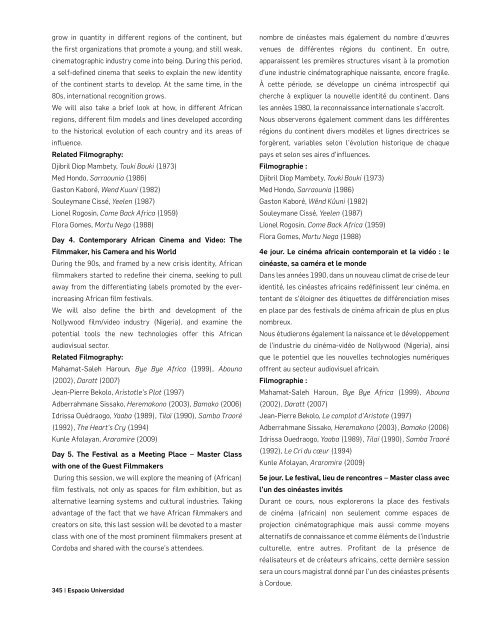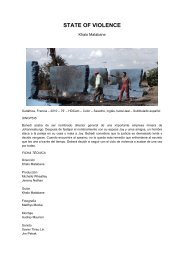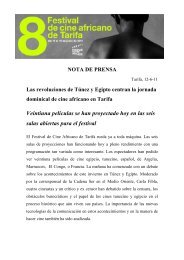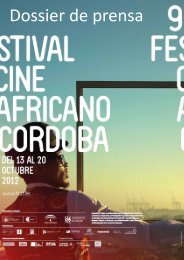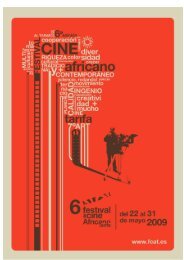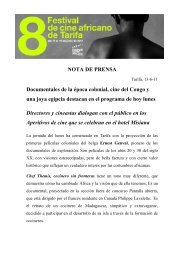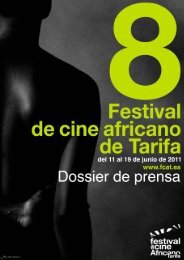Catálogo - FCAT
Catálogo - FCAT
Catálogo - FCAT
Create successful ePaper yourself
Turn your PDF publications into a flip-book with our unique Google optimized e-Paper software.
grow in quantity in different regions of the continent, but<br />
the first organizations that promote a young, and still weak,<br />
cinematographic industry come into being. During this period,<br />
a self-defined cinema that seeks to explain the new identity<br />
of the continent starts to develop. At the same time, in the<br />
80s, international recognition grows.<br />
We will also take a brief look at how, in different African<br />
regions, different film models and lines developed according<br />
to the historical evolution of each country and its areas of<br />
influence.<br />
Related Filmography:<br />
Djibril Diop Mambety, Touki Bouki (1973)<br />
Med Hondo, Sarraounia (1986)<br />
Gaston Kaboré, Wend Kuuni (1982)<br />
Souleymane Cissé, Yeelen (1987)<br />
Lionel Rogosin, Come Back Africa (1959)<br />
Flora Gomes, Mortu Nega (1988)<br />
Day 4. Contemporary African Cinema and Video: The<br />
Filmmaker, his Camera and his World<br />
During the 90s, and framed by a new crisis identity, African<br />
filmmakers started to redefine their cinema, seeking to pull<br />
away from the differentiating labels promoted by the everincreasing<br />
African film festivals.<br />
We will also define the birth and development of the<br />
Nollywood film/video industry (Nigeria), and examine the<br />
potential tools the new technologies offer this African<br />
audiovisual sector.<br />
Related Filmography:<br />
Mahamat-Saleh Haroun, Bye Bye Africa (1999), Abouna<br />
(2002), Daratt (2007)<br />
Jean-Pierre Bekolo, Aristotle’s Plot (1997)<br />
Adberrahmane Sissako, Heremakono (2003), Bamako (2006)<br />
Idrissa Ouédraogo, Yaaba (1989), Tilaï (1990), Samba Traoré<br />
(1992), The Heart’s Cry (1994)<br />
Kunle Afolayan, Araromire (2009)<br />
Day 5. The Festival as a Meeting Place – Master Class<br />
with one of the Guest Filmmakers<br />
During this session, we will explore the meaning of (African)<br />
film festivals, not only as spaces for film exhibition, but as<br />
alternative learning systems and cultural industries. Taking<br />
advantage of the fact that we have African filmmakers and<br />
creators on site, this last session will be devoted to a master<br />
class with one of the most prominent filmmakers present at<br />
Cordoba and shared with the course’s attendees.<br />
345 | Espacio Universidad<br />
nombre de cinéastes mais également du nombre d’œuvres<br />
venues de différentes régions du continent. En outre,<br />
apparaissent les premières structures visant à la promotion<br />
d’une industrie cinématographique naissante, encore fragile.<br />
À cette période, se développe un cinéma introspectif qui<br />
cherche à expliquer la nouvelle identité du continent. Dans<br />
les années 1980, la reconnaissance internationale s’accroît.<br />
Nous observerons également comment dans les différentes<br />
régions du continent divers modèles et lignes directrices se<br />
forgèrent, variables selon l’évolution historique de chaque<br />
pays et selon ses aires d’influences.<br />
Filmographie :<br />
Djibril Diop Mambety, Touki Bouki (1973)<br />
Med Hondo, Sarraounia (1986)<br />
Gaston Kaboré, Wênd Kûuni (1982)<br />
Souleymane Cissé, Yeelen (1987)<br />
Lionel Rogosin, Come Back Africa (1959)<br />
Flora Gomes, Mortu Nega (1988)<br />
4e jour. Le cinéma africain contemporain et la vidéo : le<br />
cinéaste, sa caméra et le monde<br />
Dans les années 1990, dans un nouveau climat de crise de leur<br />
identité, les cinéastes africains redéfinissent leur cinéma, en<br />
tentant de s’éloigner des étiquettes de différenciation mises<br />
en place par des festivals de cinéma africain de plus en plus<br />
nombreux.<br />
Nous étudierons également la naissance et le développement<br />
de l’industrie du cinéma-vidéo de Nollywood (Nigeria), ainsi<br />
que le potentiel que les nouvelles technologies numériques<br />
offrent au secteur audiovisuel africain.<br />
Filmographie :<br />
Mahamat-Saleh Haroun, Bye Bye Africa (1999), Abouna<br />
(2002), Daratt (2007)<br />
Jean-Pierre Bekolo, Le complot d’Aristote (1997)<br />
Adberrahmane Sissako, Heremakono (2003), Bamako (2006)<br />
Idrissa Ouedraogo, Yaaba (1989), Tilaï (1990), Samba Traoré<br />
(1992), Le Cri du cœur (1994)<br />
Kunle Afolayan, Araromire (2009)<br />
5e jour. Le festival, lieu de rencontres – Master class avec<br />
l’un des cinéastes invités<br />
Durant ce cours, nous explorerons la place des festivals<br />
de cinéma (africain) non seulement comme espaces de<br />
projection cinématographique mais aussi comme moyens<br />
alternatifs de connaissance et comme éléments de l’industrie<br />
culturelle, entre autres. Profitant de la présence de<br />
réalisateurs et de créateurs africains, cette dernière session<br />
sera un cours magistral donné par l’un des cinéastes présents<br />
à Cordoue.


